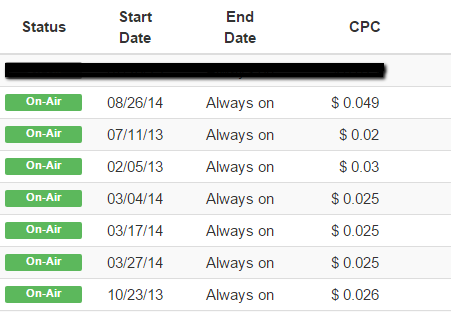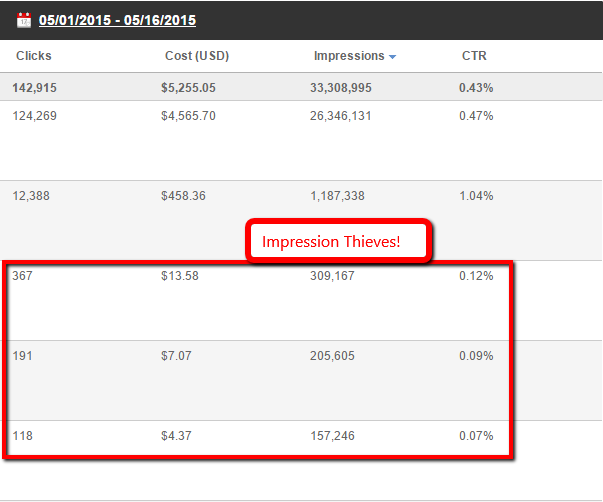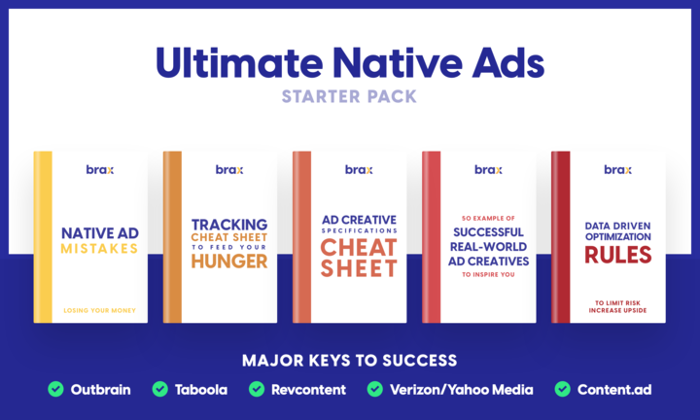Over the past 16 months we have spent $1,541,836.97 on Outbrain, Taboola and Revcontent generating 10,694,043,912 impressions and 59,149,831 clicks to our properties.
Here is a snapshot of a weekly optimization process developed and fine tuned over 16 months.
1. Raise CPC Bid then Lower
Sometimes a campaign that has been spending well will start dipping drastically even after accounting for seasonal fluctuations. Kickstart the campaign momentum by raising CPC by a penny, then set a timer for two hours.
Ideally you have some real-time analytics so you can see if the past two hours have actually increased traffic from the campaign. If so drop the CPC back down, otherwise wait another two hours and check again.
2. Establish a Baseline
We love using a data centric decision making system to automate as much as possible in regards to decisions on campaign and ad creative changes. The first step to doing this is establishing baseline metrics from historic data. For example, CTR is going to vary wildly based on the campaign messaging & goals.
Establishing a baseline allows you to quickly decide on each of the tips below if you need to take action. Some of the baseline data lives in the distribution networks and some lives in your analytics.
Suggested baselines:
- RPM for advertising
- Cost per Visitor or Lead or Customer
- CTR
- Pages per Visit
- Bounce Rate
- Avg Time on site
Here is how we structure baselines:
These are just for example purposes; it is best to look at historical data to set your own goals, minimums and thresholds to investigate. It is good to do this at both the ad creative and campaign level in our experience.
3. Kill Campaign Laggards
Are you monitoring poor performing ads then pausing them to keep your campaigns healthy? It is easy to keep adding new creatives to existing campaigns; however, the new ads may never get a fair shot because of top performers already in the campaign.
To make things worse, when the new ads are being tested for traction it is at the peril of your existing top performers because they will share impressions when in the same campaign.
Sort ads by number of impressions, then scan ad creatives for low CTR rates & minimal clicks in each campaign once a week and pause anything below a certain threshold of CTR & spend previously defined in your baseline metrics. Be careful not to pause a creative that is sending significant visits even with a low CTR.
4. Use New Campaigns for Testing New Creatives
Instead of mucking up your optimized campaigns from the previous step; put new creatives in a new campaign. Your current campaign continues to perform and the risk is where it should be with new ads in a new campaign.
Let the new ad creatives run for a week before reviewing for optimization in most scenarios depending on your available resources.
5. Separate Mobile and Desktop Campaigns
There are two main reasons we separate mobile, tablet and desktop targeting in different campaigns. First is that mobile is available at lower CPC and second is the experience is drastically different.
In fact I recommend you create baseline metrics separately for mobile vs tablet vs desktop. Some combine mobile & tablet while others combine table & desktop; for media sites we combine desktop and tablet mimicking Outbrain’s platform targeting.
6. Combine GEOs in a Campaign
For US advertisers, taking on international traffic is a bit of a quality risk for many businesses. If your business does not require customers location in a specific geography try this to scale quality traffic:
- Mix international GEOs that use same language in one campaign. We have found putting UK, CA, AU in a campaign helps it gain traction with Outbrain.
- If the above isn’t working, mix it with United States targeting. This has worked in Outbrain for multiple campaigns in the last year for us.
Before adopting the above strategy we had separate campaigns by country & device platform. Sounds great in theory but traffic just would not scale. Once we added other english speaking countries the campaign immediately gained traction compared to the previous week with a standalone US campaign continuing to stay strong.
7. Give Laggards a Second Chance
Sometimes you will have ads that never get a fair shot at proving themselves because another ad saw success early resulting in the optimization algorithm not giving enough impressions to other creatives in the campaign.
Take ads with a low impression count (under 100k) and put them in a new campaign. This is especially true if the creative is radically different from the top performer.
Even similar creatives fall prey to one catching fire faster; consider that a single word can make a major impact.
Bonus: Test, Test, Test!
All of the above activities revolve around one central philosophy that has proven itself to be very profitable when buying traffic from Outbrain and Taboola. Test as many text and image variations as possible. We have had content that wouldn’t take off for a few weeks; then a new creative hits the right nerve and our work is validated with customers.
The process of creating hundreds of ads in multiple campaigns in multiple networks is painful and time consuming when using the interfaces of Outbrain and Taboola alone. This is where Brax comes into the picture.
So what exactly does Brax do?
First it will take 5 titles and 5 images then turn them into 25 ads for content recommendation networks. Next it connects directly to your Outbrain, Taboola, Yahoo, Revcontent or Content.ad account using the Network APIs.
This is a total game changer. It took the time to create 50 ads in 4 networks from about an hour to three minutes. Create a free Brax account here.







